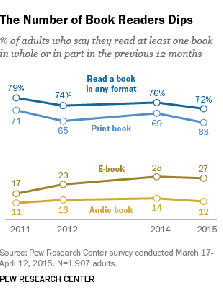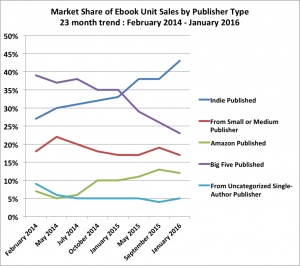Self-Publishing and the Rise of the Indie Publisher
selfSelf-Publishers are finding that they sell more books when they use an Indie Publisher
In fact, it has never been easier to self-publish your book, and the competition among companies that want to print your book has really heated up, resulting in printing prices becoming very competitive. What seems to have been a blessing for the self-publisher has become a new challenge. More authors are now publishing, adding more books to the global stack of literary works. However, the number of readers has remained static or, according to the Pew Research Group, has dropped slightly. So, with so many new books being published, who is making money? And how does a new author get his or her works noticed?
If you’re thinking about publishing or getting published, it is important to know where your best opportunities lie. In the not-so-distant past, in order to sell books, you had to print books, and lots of them to keep the cost down. The reader had to go to a bookstore or order a book and wait for it to arrive. The inventions of the e-book reader, smartphone, and tablet changed all that. The e-book readers have made it easier for individuals to browse for books and purchase the ones they want instantly. And the electronic bookstore has made it easy for self-publishers to display and sell their books to millions of readers globally.
This major shift in the publishing world raises the question: Who is selling books in this modern era? To answer this, I started with the 800-pound book gorilla, Amazon. It is interesting to see the changes in just the past few years. The big publishing firms that used to have a stranglehold on the bookselling business are seeing their market shares plummet. The self-publishing market share has risen slightly. Yet it is the dramatic rise in the indie publisher that is quickly grabbing the market share of online books.
The quickest way to go from a manuscript to the marketplace is with an indie publisher. The reason for the rise in indie publishers’ market share is that there is more to publishing these days than just having your book printed. Publishing now requires electronic books to be submitted to over 70 large online resellers, and most of the marketing and promotion are done electronically; moreover, royalty management, websites, and social media are now all part of the process. Indie publishers are helping authors succeed because they do all the hard work, including publishing, distributing, and promoting a book. Moreover, Indie publishers have experience navigating the world of electronic publishing and access to many more resources than most self-publishing authors do. For example, a self-publisher can get a single ISBN number for about $125.00 USD, while a publisher buys them in bulk, paying only a few dollars for each one. A good indie publisher will take an author through the whole process, helping him or her avoid costly mistakes. Those sales figures are just Amazon sales. Many authors are getting sales from Nook, Kobo, Smashwords, and other online retailers, and many are still selling in small indie bookstores. Others sell effectively in person, such as at conferences, readings, signings, etc.
Indie publishers combine the best of the old and the new when it comes to publishing. They bring the experience and resources of a publishing house, but authors retain control over their work and can sell a book on their own, while sidestepping all the common pitfalls of publishing and headaches of doing it themselves. Like any other professional service, there is a cost to using an indie publisher. Think of it this way—you could paint your own house, but if you don’t have the time or the skills, and you don’t want to deal with the mess, you hire a professional painter.
Happy writing!
Stephanie Anne Timmer
Get Published Not Just Printed
Stephanie Timmer
Apollo Publications
630-206-0235
email us here
Legal Disclaimer:
EIN Presswire provides this news content "as is" without warranty of any kind. We do not accept any responsibility or liability for the accuracy, content, images, videos, licenses, completeness, legality, or reliability of the information contained in this article. If you have any complaints or copyright issues related to this article, kindly contact the author above.


